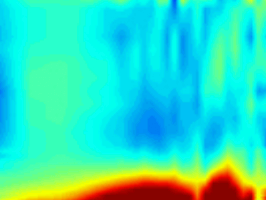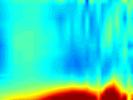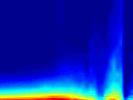
Professor Donald Wroblewski
Department of Aerospace and Mechanical Engineering
Boston University
Research Assistant:
William J. Armiger
Johns Hopkins University
This study focused on the effect of periodic unsteadiness due to vortex shedding on the heat transport, fluid dynamics, and wall heat transfer in a turbulent cylinder-wall junction boundary layer. Detailed measurements of temperature and velocity were obtained in a wind tunnel experiment. The large volume of collected data was analyzed using conditional data sampling and analysis techniques, to separate the large-scale periodic behavior from the background turbulence. The video shows color contour plots of the temperature and streamwise vorticity, in a transverse plane 6 cylinder diameters down stream of the junction, as a function of time during a “typical” periodic cycle. The temperature field displays large-scale periodic thinning and thickening of the near-wall thermal layer (evident in the video as movement of the reddish-colored regions away from and then towards the wall), which can greatly affect heat transfer at the wall. The vorticity data revealed coherent, periodic structures (seen in the video as circular or elliptical regions) that form, convect, and decay. A particularly interesting feature seen in the video is the movement of a counter-clockwise-rotating vortex (a dark blue circular region initially n the center of the plane) that moves towards the wall and eventually spawns a clock wise-rotating vortex (a reddish colored region), which then moves away from the wall.

Video Sequence
Vorticity

Video Sequence
Temperature
Hardware: SGI Power Challenge.
Software: MATLAB.
Video Production and Matlab assistance: Kathleen Curry, Scientific Computing and Visualization Group, Boston University.
Acknowledgments: William Armiger’s work on the visualization was done while he was a participant in the Research Experience for Undergraduates Program sponsored by the National Science Foundation.
